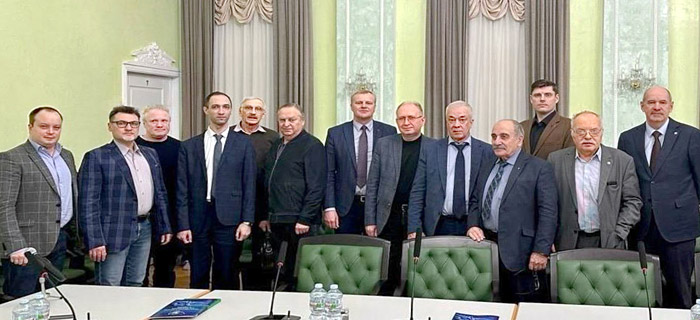
Electronic english version since 2022 |
The newspaper was founded in November 1957
| |
Meetings
About the Proton Therapy Centre in Dubna
On 19-20 February, a visit of the representatives of the State Scientific Centre FMBC named after A.I.Burnazyan and specialists from the Federal Scientific Clinical Centre for Medical Radiology and Oncology of the FMBA of Russia at JINR was held. The goal of the visit was to discuss the prospects for establishing a Scientific and Clinical Centre for Proton Therapy in Dubna.
The delegation learnt about the scientific infrastructure of JINR in LRB, DLNP and FLNR.
As part of the visit, a meeting was held at which reports were presented on the development of a proton therapy centre in Dubna. Academician of the Russian Academy of Sciences, oncologist surgeon Igor Reshetov and General Director of the Federal Scientific and Clinical Centre for Medical Radiology and Oncology of the FMBA of Russia Yury Udalov took part in the event remotely.
JINR Assistant Director for the Development of Medical and Biological Projects Grigory Shirkov gave a report on the topic "Concept of the scientific and clinical centre for proton therapy in Dubna". He presented a plan for the development of the MSC-230 cyclotron project and the supply of equipment to medical centres, including those in the JINR Member States, for the treatment of oncological diseases.
At the first stage of the project deployment, the MSC-230 prototype will be consistently installed at JINR and in parallel, a programme on the development of the latest proton therapy technologies and radiobiological research will be implemented. Next, the product will be registered in the country where JINR is located, Russia and trial operation will be carried out at the clinical centre in Dubna. Licensing and implementation of advanced medical techniques and technologies into clinical practice are provided. At the final stage, a decision will be made to launch serial production with the further possibility of supplying equipment to clinical centres of the JINR Member States and other partner countries.

Alexander Bugay, Director of the Laboratory of Radiation Biology, presented a report on the topic of radiobiological research using proton beams. Natural extension of the center's project, according to the scientist, is a programme of fundamental research and its applications in the development of new technologies and techniques of proton therapy.
A broad research programme is currently implemented at JINR both in the field of fundamental radiobiology and its applications - in radiation medicine, space exploration, in the fields of radiation safety and astrobiology. At JINR, projects on extracted beams of the NICA accelerator complex and other experimental facilities, interlaboratory projects in the field of bioinformatics, as well as work with biological objects and cell cultures are carried out.
DLNP chief engineer Sergey Yakovenko reported on the status of implementation of the "Medical superconducting cyclotron MSC-230" project. The project is developed jointly with NIIEFA named after D.V.Efremov. Based on the unique JINR technology for the production of superconducting magnets, the Joint Institute will produce superconducting coils and a cryogenic system for MSC-230. The production of its main parts, such as the superconducting magnet winding, cryostat and helium refrigerator will be carried out during 2024. Further, JINR is going to develop control units for the installation subsystems, as well as to manufacture the output system, resonance and vacuum systems of the cyclotron. Completion of the MSC 230 cyclotron is scheduled for early 2025.
The report by Head of the Radiation Medicine and Biology Sector at DLNP Gennady Mitsyn was dedicated to the peculiarities of beam production for proton flash therapy at the MSC-230 accelerator. The flash therapy technique involves delivering a therapeutic dose of radiation to the tumor volume at an ultra-high dose rate in the beam, several orders of magnitude higher than that usually used in standard radiotherapy. In this mode of irradiation, the degree of damage to normal tissues surrounding the tumor and exposed to radiation is reduced, but at the same time, the effect on cancer cells remains at almost the same level that improves the prospect of local tumor control with a lower incidence of side effects.
Some ideas and solutions for implementing the new project were tested using beams from the now decommissioned JINR phasotron with a proton energy of 660 MeV and a maximum current of 1 mA. The task was to produce a beam of uniform cross-section with a diameter sufficient to irradiate both cell cultures and small laboratory animals, such as mice and rats and with a dose rate required for flash effect radiation (at least 40-50 Gy/s). In addition, such a beam was also useful for testing various detectors being developed for dosimetry under conditions of ultra-high dose rates in terms of the implementation of a future project.
The results of the meeting were summed up during a discussion, during which participants discussed plans and further development strategy for the Proton Therapy Centre in Dubna.
JINR Press Office